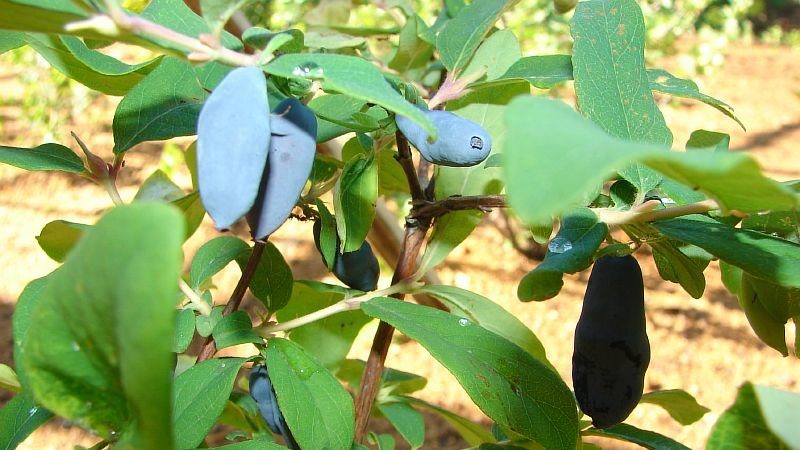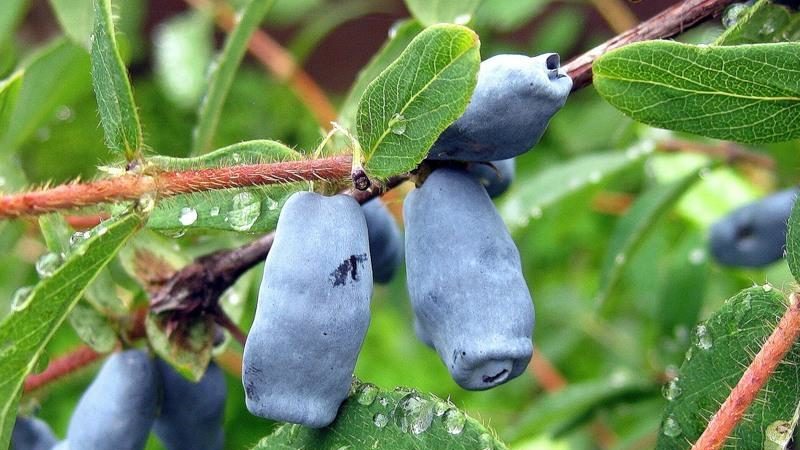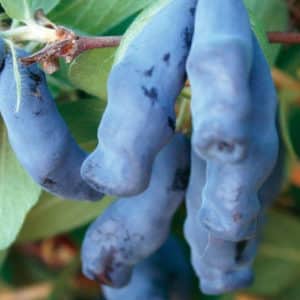Edible honeysuckle variety “Lebedushka” for fresh consumption and making desserts
Lebedushka is far from a new variety of honeysuckle, but its popularity among summer residents remains stable. This is explained by its positive characteristics, including not only the pleasant taste of the fruit, but also frost resistance, unpretentiousness and the decorative appearance of the bushes.
What kind of honeysuckle is this?
Lebedushka is a medium-ripening variety of edible honeysuckle. Approved for cultivation in all regions.
Fruiting begins 3-4 years after planting, the average yield is 40 c/ha. The fruits have dense flesh, which has a beneficial effect on keeping quality and transportability.
Brief history of origin and distribution
Mostly honeysuckle grows in the northern hemisphere. Most of the shrubs are ornamental - the fruits that appear on them are not eaten. The plant began to be cultivated at the beginning of the 20th century. During this time, breeders have developed many edible varieties, one of which is Lebedushka.
This is a honeysuckle of the Kamchatka line. The variety was bred by breeders of the All-Russian Institute of Plant Genetic Resources named after. N.I. Vavilova (St. Petersburg) based on Pavlovskaya honeysuckle and seedlings of form No. 21-1.
The variety was included in the State Register of Russia in 1999.
Characteristics and description of bushes

Swan is a vigorous (height about 2 m), moderately spreading bushes with a rounded crown and straight, strong branches.Young shoots are smooth and have a brown-green tint; the bark on older ones is browner and peels off over time.
The leaves are large, elongated oval in shape with a pointed base and apex, slightly convex, colored rich green.
During flowering, which occurs in early May, medium-sized yellowish flowers appear in the leaf axils, arranged in pairs.
Reference. Landscape designers often use this variety of honeysuckle to decorate gardens and create hedges.
Temperature resistance
The bushes can withstand temperatures dropping to -40...-50°C and are not afraid of return frosts in the spring. They do not require shelter even when grown in northern regions.
Moisture and drought resistance
The variety is characterized by an average degree of drought resistance. This means that the bushes tolerate the absence of watering for a month and still bear fruit, but with a longer lack of moisture, the yield decreases, the berries lose weight, and bitterness appears in their taste.
With excessive watering and stagnant moisture, there is a risk of rotting of the root system.
Resistance to diseases and pests
The variety is resistant to most diseases, but if agrotechnical requirements are violated, the following may develop:
- powdery mildew;
- cercospora;
- mosaic virus;
- bacterial cancer.
Among the pests, the greatest danger to Lebedushka is aphids; there is also a risk of damage from mites, fingerwings and caterpillars.
Characteristics and description of fruits

The berries are elongated-cylindrical, barrel-shaped, grow up to 2.7 cm in length and weigh 1.2-1.6 g. The skin is dense, lumpy, bluish-blue in color with a slight waxy coating.
The flesh is beige with a green tint, dense and gristly. It has a sweet and sour taste and a soft, pleasant aroma.
The fruits contain 8.4% sugar, 2% acid, 63.6 mg of ascorbic acid, as well as iodine, zinc, silicon, pectin, potassium, vitamins A, C, B.
Areas of their application
Lebedushka fruits are distinguished by their ability to be used universally. They are suitable for fresh consumption, freezing, making compotes, juices, preserves, jams and other types of preservation. They are also used as a filling for baked goods and in the making of homemade wines.
Leaves and branches are used in folk medicine to prepare medicinal decoctions and infusions.
Advantages and disadvantages of the variety
Advantages of honeysuckle Lebedushka:
- pleasant dessert taste and rich chemical composition of berries;

- good transportability;
- decorative appearance of bushes and the possibility of their use in landscape design;
- frost resistance;
- early fruiting;
- possibility of universal use of fruits;
- slow development of shoots in the first years of life;
- good immunity to diseases and pests;
- low crumbling.
Disadvantages of the variety:
- susceptibility to aphid attacks;
- difficult harvesting;
- the presence of sourness in the taste.
Growing technology
Despite the unpretentiousness and hardiness of the variety, to obtain healthy, abundantly fruiting shrubs, proper care and comfortable conditions are required.
Suitable for planting are seedlings 35-40 cm long with a closed root system and 3-4 strong shoots.
Reference. In order for bushes with an open root system to take root better, before planting they are placed in a solution of a growth stimulator (Epin, Kornevin) for 2-3 hours.
Optimal conditions
Honeysuckle is planted in an area protected from the wind and well lit.. In partial shade, the bushes grow and develop well, but the lack of light negatively affects the yield and taste of the berries.
Overmoistening is detrimental to the root system of plants. Therefore, when choosing a place for planting, check the level of groundwater - it must be at least 1 m from the surface of the earth.
Swan prefers light, fertile soil with good aeration, moisture permeability and low or neutral acidity. The best option is medium or slightly podzolized soil, loam or sandstone.
Landing dates and rules
Swan is planted in spring (March) or late summer-early autumn (August-September).
Reference. When planted in spring, bushes often get sick, lag in growth and do not have time to adapt to the beginning of the early growing season.
Planting pattern:
- Dig planting holes measuring 40x40 cm.
- Fill the bottom with a layer of drainage made of broken bricks, pebbles or crushed stone.
- Sprinkle a nutrient mixture on top (half the dug up soil, 2 buckets of compost, 1 liter of ash, 50-60 g of superphosphate).
- Form a hill of soil in the center, install a seedling on it and straighten its roots.
- Fill all the voids in the hole and water (water consumption - 2 buckets per bush).
- When the soil settles after watering, add more nutrient mixture so that the root collar is buried 2-3 cm.
The distance between bushes should be at least 1 m, between rows - 2 m.
Further care
Honeysuckle is watered 1-2 times a week, pouring 10-15 liters of water under each bush. The frequency of watering is increased as needed, for example, in hot and dry summers.
Reference. To retain moisture in the soil, it is mulched with peat.
After watering or rain, the soil is loosened to improve the saturation of the roots with moisture and oxygen, and weeded, removing weeds that thicken the area.
Plants begin to be fed 1-2 years after planting. In the spring, 5-8 kg of manure is applied to each bush, in the fall - complex mineral fertilizers, preferably those with a high content of potassium and phosphorus.
In the spring (before buds open) and autumn (before frosts), sanitary pruning is carried out, removing old, damaged and inward-growing branches from the bushes. For bushes older than 7 years, rejuvenation is carried out every 3 years pruning – in the fall, cut off all the shoots, leaving stumps 30-40 cm long.
Possible problems, diseases, pests
Diseases that can affect Swan:
| Disease | Symptoms | Treatment |
| Powdery mildew | A white coating forms on the back of the leaves | Treatment with drugs “Tiovit”, “Topaz” |
| Cercospora | White spots with brown edges appear on the leaf blades | Spraying bushes with Fundazol or copper sulfate |
| Mosaic virus | Leaves develop poorly and become smaller | There is no treatment. Affected bushes are dug up and burned |
| Cancer | Ulcers appear on the wood | Plants are dug up and burned. To prevent disease, bushes are treated with copper sulfate in autumn, spring and during flowering. |
Among the pests for this variety, aphids are especially dangerous. To prevent its occurrence, plants are sprayed with garlic-pepper infusion. If insects have already attacked the bushes, treat them with insecticides (Aktara, Biotlin, Iskra).
Plants can also be attacked by mites, fingerwings and caterpillars. To combat them, insecticidal preparations (Inta-Vir, Actellik) are used.
Reference. The use of insecticides is allowed only before budding and after harvest.
Wintering
Plants begin prepare for winter at the beginning of October. To do this, the bushes are pruned, and the ground on the site is weeded and cleared of plant debris and other biological debris to avoid the risk of pests and fungal diseases.
After this, the soil is loosened, phosphorus-potassium fertilizers are applied, sprinkled with fungicides (Vectra, Gamair) and insecticides (Akarin, Aktara) to prevent diseases and the appearance of insects, and mulched with peat.
The bushes tolerate frost well and do not need shelter.
Reproduction
Swan is propagated by green or lignified cuttings, layering and dividing the bush.
In the summer, after harvesting, green cuttings 7-12 cm long are cut from the central part of the stems so that each has 4 internodes with a bud and a leaf. In autumn or early spring, lignified cuttings with 3-5 internodes on each are prepared.
The cuttings are treated with a growth stimulator (Kornevin), placed in a peat-sand mixture (proportions 1:2), deepened by 2-4 cm, and the container with the plants is covered with polyethylene. The soil is watered daily and the greenhouse is ventilated. Cuttings take root after 2-3 weeks.
For mature plants, the division method is used. The bushes are dug up, the root system is divided into several parts, the cuts are treated with an ash solution, and then planted in a permanent place.
To propagate by layering, select a strong shoot growing below, bend it to the ground and dig it in. When it forms an independent root system, it is separated from the mother bush and planted in the ground.
Features of growing this variety, depending on the region
The technology for growing Lebedushka does not depend on the region, only the optimal timing varies landings seedlings. So, in a temperate climate it is better to plant plants in mid-September, and in the southern regions - in early October.
Reference. In the case of spring planting, they are guided by the time of snow melting.
Pollinator varieties
This crop is self-sterile, so suitable pollinating varieties are planted nearby.
The best pollinators for the Swan:
- Kamchadalka;
- Moraine;
- Blue bird;
- Malvina;
- Blue spindle.
Reference. To increase the likelihood of pollination, 3-6 different varieties are planted nearby.
Reviews from summer residents
Gardeners liked the variety, as evidenced by their positive reviews.
Maria, Ufa: “I grow Lebedushka for myself, the yield is not high enough to be enough for sale. I like this variety because it gives very tasty and healthy berries, which do not fall off immediately after ripening. The bushes are very beautiful, I have a whole hedge of them on my property. The only disadvantage of the variety is its susceptibility to aphids.”
Natalya, Voronezh: “I’ve been growing this honeysuckle for more than 6 years, I’ve tried other varieties, but somehow they didn’t take root with me. I love the swan for its large, tasty fruits, frost resistance and unpretentiousness.”
Victoria, Nizhnevartovsk: “Since several varieties of honeysuckle grow on the site, I can definitely say that I love Lebedushka the most. A completely unpretentious plant, you don’t even need to cover it for the winter. The main thing is to water regularly and trim dry branches. The bushes are very beautiful, and the berries are tasty and healthy.”
Conclusion
Swan is one of the first varieties of edible honeysuckle that breeders developed. Despite not the highest yield, many summer residents prefer to grow it.This is explained by the unpretentiousness, frost resistance of the bushes and the pleasant taste of large berries.